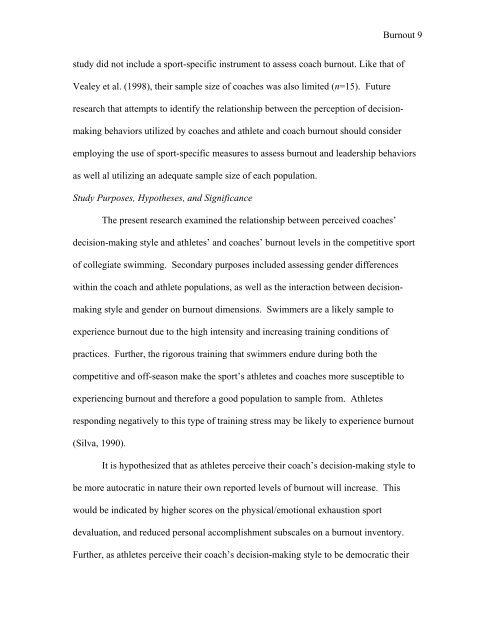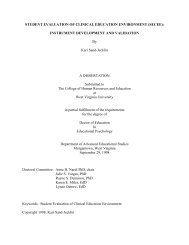Coach and Athlete Burnout - West Virginia University
Coach and Athlete Burnout - West Virginia University
Coach and Athlete Burnout - West Virginia University
Create successful ePaper yourself
Turn your PDF publications into a flip-book with our unique Google optimized e-Paper software.
<strong>Burnout</strong> 9<br />
study did not include a sport-specific instrument to assess coach burnout. Like that of<br />
Vealey et al. (1998), their sample size of coaches was also limited (n=15). Future<br />
research that attempts to identify the relationship between the perception of decision-<br />
making behaviors utilized by coaches <strong>and</strong> athlete <strong>and</strong> coach burnout should consider<br />
employing the use of sport-specific measures to assess burnout <strong>and</strong> leadership behaviors<br />
as well al utilizing an adequate sample size of each population.<br />
Study Purposes, Hypotheses, <strong>and</strong> Significance<br />
The present research examined the relationship between perceived coaches’<br />
decision-making style <strong>and</strong> athletes’ <strong>and</strong> coaches’ burnout levels in the competitive sport<br />
of collegiate swimming. Secondary purposes included assessing gender differences<br />
within the coach <strong>and</strong> athlete populations, as well as the interaction between decision-<br />
making style <strong>and</strong> gender on burnout dimensions. Swimmers are a likely sample to<br />
experience burnout due to the high intensity <strong>and</strong> increasing training conditions of<br />
practices. Further, the rigorous training that swimmers endure during both the<br />
competitive <strong>and</strong> off-season make the sport’s athletes <strong>and</strong> coaches more susceptible to<br />
experiencing burnout <strong>and</strong> therefore a good population to sample from. <strong>Athlete</strong>s<br />
responding negatively to this type of training stress may be likely to experience burnout<br />
(Silva, 1990).<br />
It is hypothesized that as athletes perceive their coach’s decision-making style to<br />
be more autocratic in nature their own reported levels of burnout will increase. This<br />
would be indicated by higher scores on the physical/emotional exhaustion sport<br />
devaluation, <strong>and</strong> reduced personal accomplishment subscales on a burnout inventory.<br />
Further, as athletes perceive their coach’s decision-making style to be democratic their












